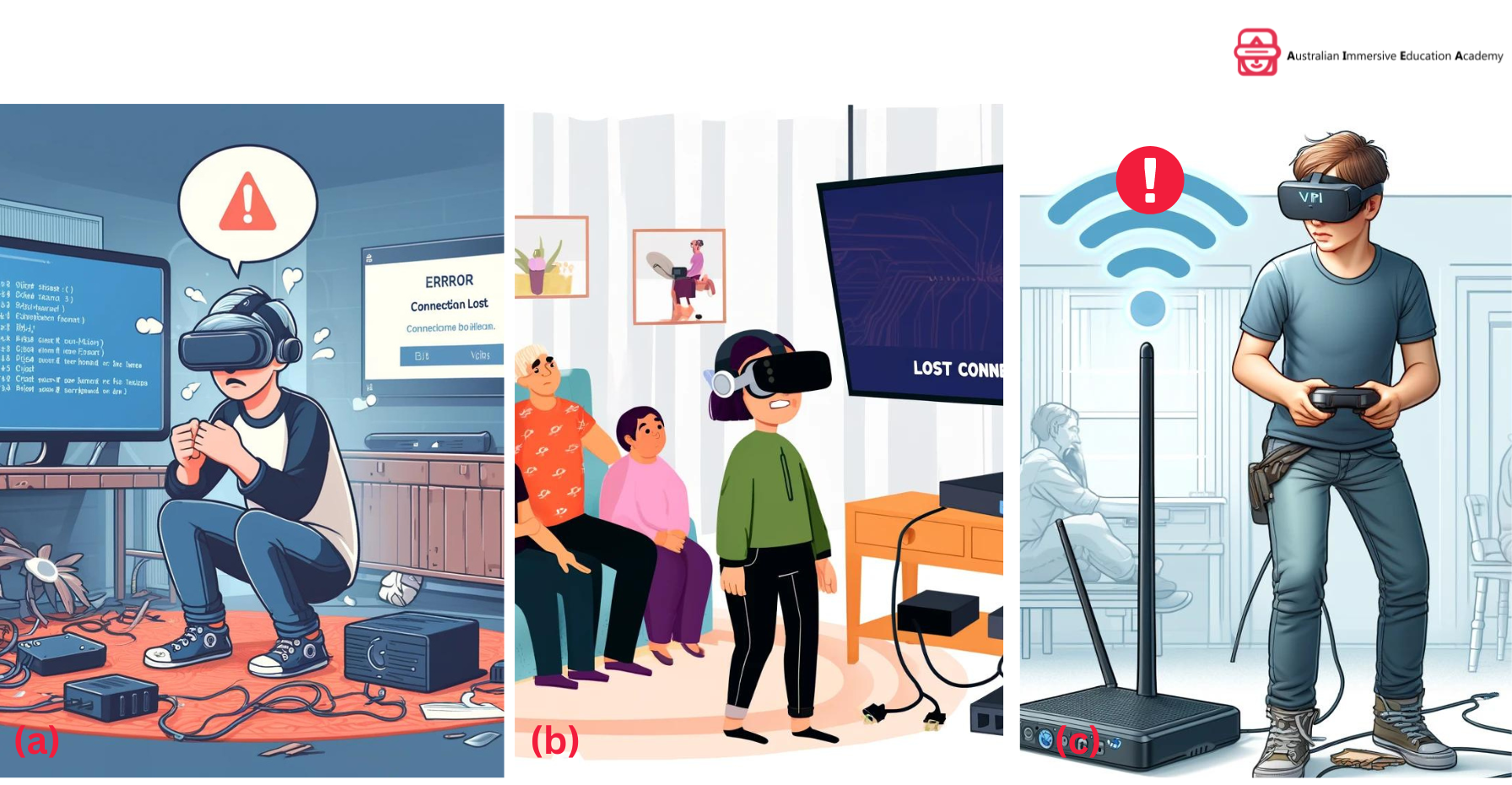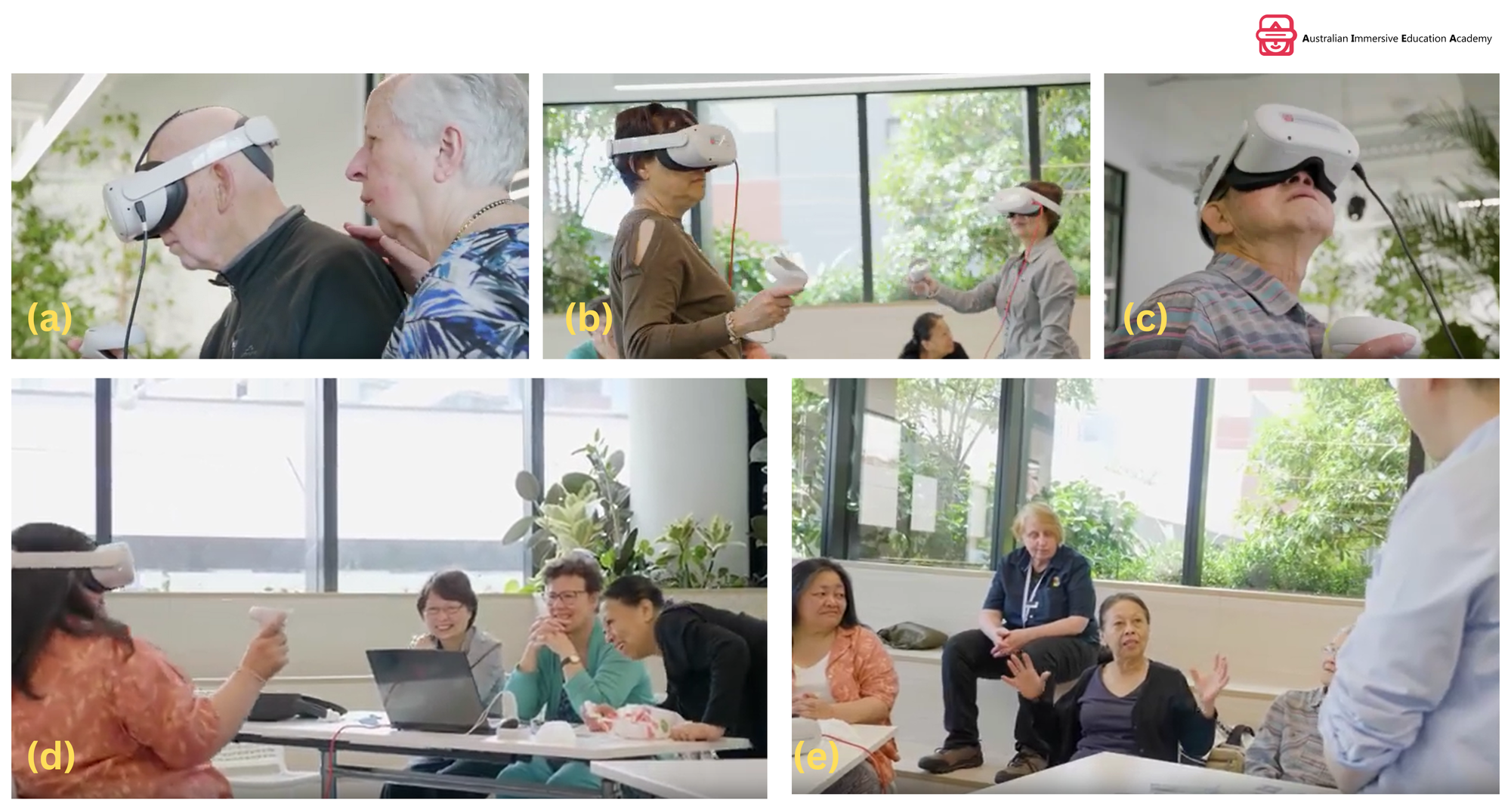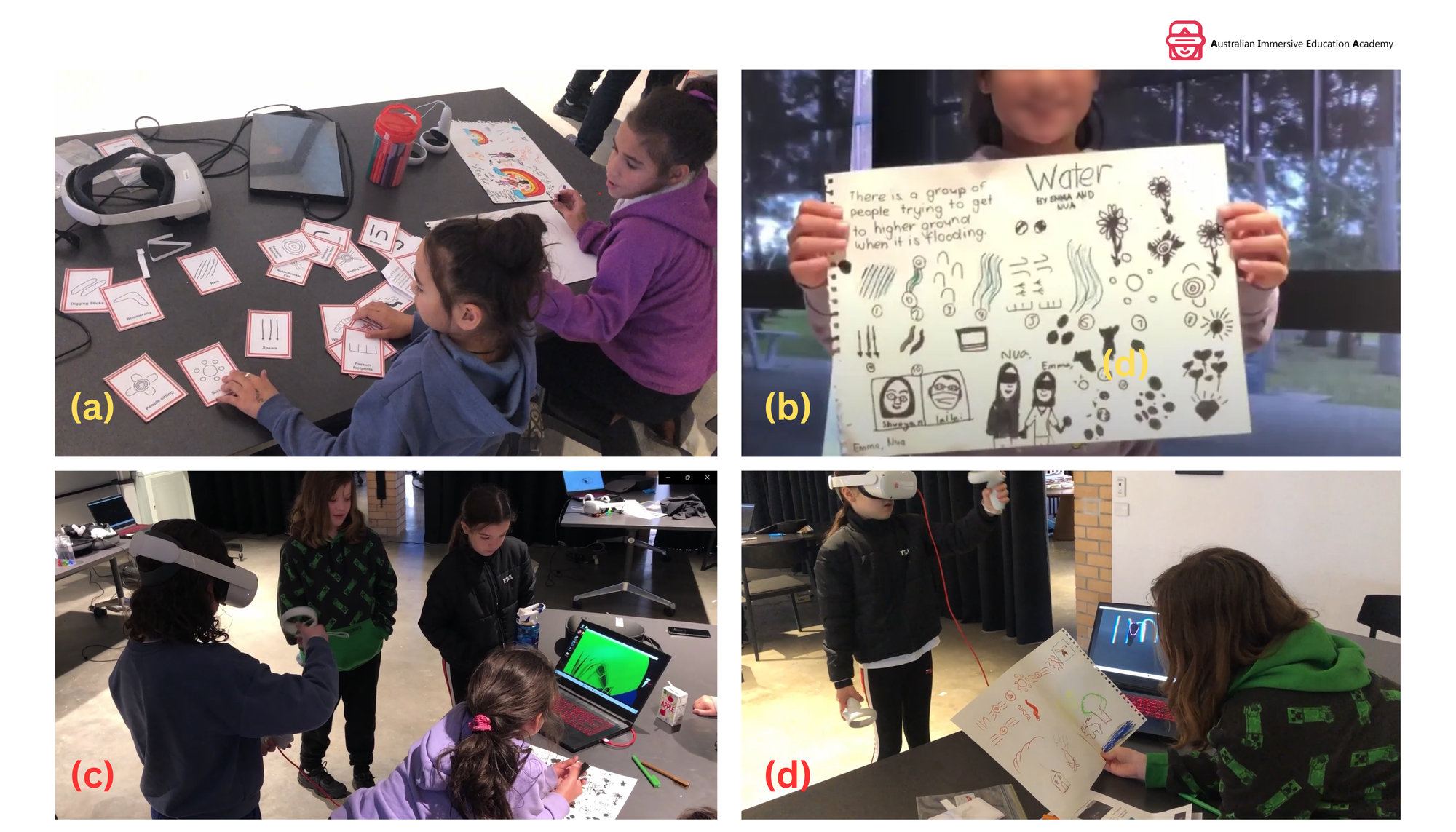Bridging the Gap: How Virtual Reality can Foster Inclusivity

Summary:
This article summarizes my past seven years of experience in empowering diverse communities through inclusive Virtual Reality (VR) and Augmented Reality (AR) programs at the Australian Immersive Education Academy (AIEA)*.
In section one, I describe the current gap (as of mid-2024) in VR adoption by discussing both the benefits and barriers of delivering inclusive VR programs in the community sector. After clarifying the key benefits and barriers, I provide concrete examples in section two on how AIEA designed, created and delivered inclusive programs to address this gap, serving diverse and underserved communities, including teenage girls, seniors, people with special needs, and First Nation communities. At last, I conclude the article by highlighting what needs to be done next to further bridge the digital divide and ensure that the transformative power of spatial computing is accessible to all, fostering more inclusive and empowered local communities.
Section 1: The Gap - Benefits and Barriers of VR Adoption
1.1 The Benefits
(1) Experience the Impossibilities

One of the most compelling aspects of VR is its ability to provide a participant experiences that are otherwise impossible or inaccessible. Whether it's exploring distant planets, traveling through time, or engaging in thrilling adventures, VR breaks down the barriers of experiencing reality.
For underserved communities, this can mean exposure to new opportunities, perspectives, and possibilities that were previously out of reach to them. As a result, VR has the power to expand horizons and inspire individuals to dream beyond their current circumstances. This aspect is particularly beneficial for seniors and people with special needs. Concrete examples from my past work will be presented in the section below.
(2) Learn with the Ultimate Empathy Machine

Virtual Reality has the unique ability to transport users into another entity's perspective, fostering empathy, understanding and situated knowledge. The entity and the perspective may be other persons' stigma situations, unbearable living conditions. It may also be a real-world scenario such as global warming, space adventure or a significant historical event.
As a result, VR can provide a deeper, more experiential, tangible understanding of complex issues. This first-hand experience can evoke a strong emotional response and create a lasting impact on the user's perception and knowledge of the topic. Detailed examples from my work at AIEA will be discussed below.
(3) A New Dimension for Creativity and Self-expression

VR offers a boundless canvas for creativity and self-expression. It enables players to imagine, create, explore, and interact with 3D virtual environments in ways that are not possible in the physical world. From artistic endeavors to problem-solving scenarios, it provides a platform for individuals to showcase their talents and ideas, fostering a sense of empowerment and confidence.
This is particularly valuable for communities that may have limited interests with traditional technologies (e.g., a good percentage of young girls) or those face limitations in traditional creative outlets (e.g., young people on the autism spectrum). Again detailed examples are discussed in the section below.
1.2 The Barriers of VR Adoption
Despite the rapid advancements in VR technology, there are still significant barriers to widespread adoption. Based on our years of work and experiences I will list three main barriers and two additional ones below.
(1) Technology Barrier
Firstly, the technical complexity of setting up and using VR systems can be intimidating for those who are not tech-savvy.

Particularly, compared with the hand inputs (e.g., typing, touching) with a laptop or a smart-phone, Virtual Reality engages the entire body of a user. The inputs includes head, hands, arms, body, even facial and eye tracking (e.g., with the latest devices like Meta Quest 3 and Apple Vision Pro). The complexity of the input devices added potential hardware/software failure points.
Besides, extra hardware i.e., HDMI cable, another digital screen are needed to broadcast the VR player's view with people outside. This setup is essential to share the VR experience with families and friends. The additional software and hardware adds another layer of technology complexity.
Lastly, many VR experiences require fast internet connection, which added yet more software and hardware configuration. It made it harder to unleash the full potential of VR experiences, especially for under-resourced communities.
(2) Economic Barrier
The cost of high-quality VR equipment can be prohibitive for many individuals and communities. Low-income communities may struggle to afford the necessary hardware and software, as well as the high-speed internet connectivity required for optimal VR experiences.

This digital divide can exacerbate existing inequalities and limit the potential for VR to promote inclusivity and empowerment. The Figure above demonstrate the current mainstream VR headset (Meta Quest 3). The lower-entry version Quest 2 cost around $1200. The high-end Apple Vision Pro cost $7500.
(3) Health and Behavioral Concerns
While VR has many benefits (e.g., those mentioned above), there are also concerns about its impact on health and behavior. For example, some users may experience motion sickness, eye strain, or disorientation when using VR for extended periods. As a result, Virtual Reality sessions of various natures need to be planned ahead. Precautions, procedures and facilitation experiences are needed to reduce the risk. There are also concerns about the potential for addiction or escapism, particularly among vulnerable populations (e.g., children and young people). Therefore, good communications and guidelines are essential for community adoption.
Addressing these health and behavioral concerns is crucial to ensure that VR is used in a safe and responsible manner.
(4) Other Barriers
The three barriers of VR adoption in communities mentioned above are only the main ones. Two other examples are space limitation and lack of understanding.
Space Limitation: Engaging in VR experiences often requires a dedicated physical space that allows users to move freely and safely while immersed in the virtual environment. This can be a significant barrier for some under-resourced communities. Without a properly prepared room, users may be at risk of injury or may not be able to fully engage in the VR experience. This limitation intensifies if multiple VR experiences are needed to serve more people at the same time.
Lack of Understanding: Despite the growing popularity of VR technology since 2016, I find there is still a lack of understanding and awareness about its potential benefits among many community members. Some individuals may view VR as merely a gaming or entertainment tool, without realizing its transformative potential in areas such as education, creativity, and social empowerment. Addressing the lack of understanding and dispelling misconceptions about this technology is crucial for maximizing the benefits.
1.3 Inclusive VR Programs
Based on the discussions above, we can give a proper definition to the core subject of this article - Inclusive VR Programs.
On one hand, Inclusive VR programs focus on promoting empathy, creativity, self-expression, and learning through immersive experiences that enable participants to explore new perspectives, develop skills and connect with others in meaningful ways.
On the other hand they are designed to address the barriers to VR adoption, including technological, economic, health and social challenges, by providing tailored experiences, support and resources that cater to the specific needs and interests of each community.

Section 2: Inclusive VR Programs - Examples and Observations
2.1 VR for Girls
(1) Promote Creativity and Self-expression
VR technology offers unique opportunities for girls to explore their creativity and self-expression. For example through VR storytelling, girls can create and share their own narratives, fostering a sense of empowerment and confidence. By immersing themselves in virtual worlds and characters, girls can experiment with different identities and perspectives, promoting empathy and understanding.

As another example, VR 3D art creation allows girls to express themselves (e.g., their multicultural identity) in new and innovative ways, breaking free from traditional gender stereotypes and expectations.

(2) Promote STEM Learning
Moreover, VR can be a powerful tool for promoting technology and STEM learning among girls. Despite the growing demand for STEM skills, girls are often underrepresented in these fields due to societal biases and lack of exposure. However, the experiential nature of VR and its ability to engage the full body can make technology more accessible and appealing to girls who may not otherwise be interested. By providing immersive experiences that showcase the real-world applications of STEM, VR can inspire girls to pursue careers in these fields and help close the gender gap in technology.

2.2 VR for Seniors
(1) Promote Memory Recall and Cognitive Stimulation
For seniors, VR technology can be a valuable tool for promoting memory recall and cognitive stimulation. By using applications like Google Earth VR, seniors can revisit places from their past, such as childhood homes or favorite vacation spots. These virtual experiences can evoke powerful memories and emotions, helping to keep the mind active and engaged.

(2) Reduce Isolation and Loneliness
VR also allows seniors to connect with the world and other people in exciting ways, event if physical limitations or mobility issues make it hard for them. For example, through VR seniors can experience activities that may otherwise be inaccessible, such as diving in the ocean or space exploration. These immersive experiences can promote a sense of wonder and curiosity, helping to reduce feelings of isolation. Moreover, by providing opportunities for seniors to share their experiences (both in VR and related life stories) with others (e.g., families and friends), VR programs can reduce loneliness, improve overall wellbeing and quality of life for seniors.

2.3 VR for People with Special Needs
(1) Promote a Sense of Freedom and Independence

For individuals with special needs, VR can open up new possibilities for connection and engagement with the world. Similar to the benefits for seniors, VR allows people with physical or cognitive limitations to experience activities that may be challenging or impossible in the real world. For example, someone with mobility issues can use VR to explore underwater environments or visit distant planets, promoting a sense of freedom and independence.
(2) Promote Self-expression and Creativity

VR can also be a powerful tool for promoting self-expression and creativity among people with special needs. For example, after going through an immersive VR experience, individuals can express the life-like experiences through art creation (both 2D on paper or 3D in VR). We have noticed that several participants on autism spectrum (e.g., with limited social and communication skills) enjoyed the immersive VR programs. Usually they would created either 2D or VR art related to their experiences. These observations made us believe that by customizing and providing a safe and supportive environment, VR programs can help promote self-expression and confidence for this audience.
2.4 VR for First Nation Youth
(1) Promote Cultural Identity and Storytelling
For First Nation youth, VR technology can be a valuable tool for promoting cultural identity and storytelling. Through VR art creation, youth can create virtual representations of traditional art forms, learning, preserving and sharing their cultural heritage with a wider audience. Additionally, VR storytelling allows youth to create and share their own narratives, promoting a sense of pride and connection to their community and history.

(2) Promote STEM Learning
This point is similar to the one in VR for girls mentioned above. By providing immersive experiences that showcase the real-world applications of STEM, VR can inspire youth to pursue careers in these fields and help build a more diverse and inclusive technology workforce.
Section 3: Inclusive VR Programs - What's Next?
Over the past seven years, the Australian Immersive Education Academy (AIEA) has conducted hundreds of VR programs spanning dozens of topics, positively impacting the lives of thousands of community members in NSW, particularly those from underserved and diverse backgrounds, such as teenage girls, seniors, people with special needs, and First Nation youth.
Since late 2016, we have witnessed firsthand the rapid evolution and maturation of VR technology, as well as the exponential growth of the content ecosystem. These advancements have unlocked unprecedented opportunities for promoting inclusivity, empathy, creativity, and learning.
However, despite the increasing positive potential of VR, we recognize that significant gaps still exist in bringing these benefits to a wider audience while simultaneously addressing the barriers to adoption. The technological, economic, health, and social challenges discussed earlier in this post continue to hinder the widespread implementation of inclusive VR programs.
We firmly believe that bridging these gaps is essential to creating a more equitable and empowered society, where everyone has the opportunity to benefit from the immersive, empathetic, and educational experiences that VR offers.
Acknowledgment
I would not have been able to complete the various initiatives mentioned above without the dedicated support from other team members of the Australian Immersive Education Academy. I want to give a special thanks to Shuoyan Zhu, who co-founded AIEA with me and has put an incredible amount of hard work over the past seven years. I'd also like to express my gratitude to Philip Mallon for his mentorship and to Guiyin Zheng for her constant support.
Besides, I'd like to acknowledge and thank two AI Large Language Models - Anthropic's Claude 3 and OpenAI's GPT-4 - for assisting me in writing this article by providing grammar checks, suggesting improvements to coherence and offering valuable discussions throughout the writing process.